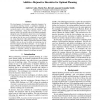Free Online Productivity Tools
i2Speak
i2Symbol
i2OCR
iTex2Img
iWeb2Print
iWeb2Shot
i2Type
iPdf2Split
iPdf2Merge
i2Bopomofo
i2Arabic
i2Style
i2Image
i2PDF
iLatex2Rtf
Sci2ools
AIPS
2008
2008
Additive-Disjunctive Heuristics for Optimal Planning
The development of informative, admissible heuristics for cost-optimal planning remains a significant challenge in domain-independent planning research. Two techniques are commonly used to try to improve heuristic estimates. The first is disjunction: taking the maximum across several heuristic values. The second is the use of additive techniques, taking the sum of the heuristic values from a set of evaluators in such a way that admissibility is preserved. In this paper, we explore how the two can be combined in a novel manner, using disjunction within additive heuristics. We define a general structure, the Additive
| Added | 02 Oct 2010 |
| Updated | 02 Oct 2010 |
| Type | Conference |
| Year | 2008 |
| Where | AIPS |
| Authors | Andrew Coles, Maria Fox, Derek Long, Amanda Smith |
Comments (0)

